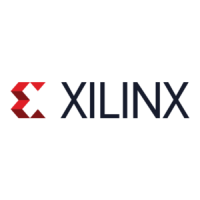
Do you have a question about the Xilinx XC4000 Series and is the answer not in the manual?
| Brand | Xilinx |
|---|---|
| Model | XC4000 Series |
| Category | Controller |
| Language | English |
Details specific enhancements for XC4000EX/XL families, including higher capacity and routing.
Information on low-voltage XC4000L and XC4000XL device variants.
Overview of XC4000-Series FPGAs, their benefits, and history.
General description of the XC4000-Series architecture, software support, and applications.
Discusses performance improvements in XC4000E/EX over older families, citing MHz rates.
States that XC4000-Series -3 and faster speed grades are PCI compliant.
Details the significantly faster carry logic chain in XC4000-Series devices.
Describes the on-chip RAM configuration options for synchronous and edge-triggered writes.
Explains the dual-port RAM option for 16x1 configurations within CLBs.
Covers the common clock enable input for IOB flip-flops, enhancing versatility.
Discusses globally configurable input thresholds for TTL and CMOS levels.
Highlights additional vertical and horizontal interconnect lines in the XC4000EX.
Covers dedicated early clock buffers for fast input data capture and output.
Notes the ability to configure CLB storage elements as latches in XC4000EX.
Describes the IOB output multiplexer for pad sharing or 2-input function generation.
Introduces a new slave configuration mode accepting parallel data input for faster rates.
Mentions extended addressing in Master Parallel configuration mode for larger devices.
Introduces CLBs, IOBs, TBUFs, wide edge decoders, and an on-chip oscillator.
The core logic elements providing programmable functionality.
Explains the two D-type flip-flops in CLBs with common clock and enable inputs.
Describes the optional latch configuration for CLB storage elements in XC4000EX.
Details the common clock pin K for CLB flip-flops, with independent invertibility.
Explains the active-High clock enable signal (EC) shared by CLB storage elements.
Covers the asynchronous storage element input (SR) for set or reset configuration.
Describes the dedicated global set/reset net (GSR) for synchronous reset of storage elements.
Details how storage element data inputs are driven and CLB outputs are generated.
Explains how control inputs map to internal signals like EC, SR/H0, DIN/H2, and H1.
Discusses using CLB flip-flops for pipelined designs to increase performance.
Lists RAM array sizes (16x2, 32x1, 16x1) and timing modes (edge-triggered, level-sensitive).
Guides selection of RAM mode based on timing, resources, and design simplicity.
The core logic elements providing programmable functionality.
Details how CLB pins function as address, data, and control lines for RAM configurations.
Explains the timing and operation of edge-triggered single-port RAM, similar to data registers.
Describes dual-port RAM operation for simultaneous read/write at two addresses.
Explains how RAM contents are initialized during device configuration, defaulting to zeros.
Covers input paths, registers (flip-flop/latch), and global configuration of input thresholds.
Explains input register behavior, including clock enable and storage element modes.
Details output buffer configurations, including slew rate, pull-up/down, and 3-state control.
Discusses optional delay elements in IOBs to ensure zero hold time for inputs.
Describes an optional latch in XC4000EX IOBs for fast input data capture synchronized to internal clocks.
Details the XC4000EX IOB output multiplexer for pad sharing or 2-input function generation.
Explains the use of programmable pull-up and pull-down resistors for unused pins.
Mentions separate clock signals for IOB input and output flip-flops, with independent inversion.
Covers special early clocks sourced by global buffers for faster IOB access.
Details very fast clocks driven by FastCLK buffers for minimal setup and clock-to-out times.
Describes the use of the Global Set/Reset signal (GSR) for IOB registers.
Mentions embedded logic for IEEE 1149.1 boundary scan testing.
Explains buffers associated with CLBs for driving longlines and implementing buses.
Details the internal oscillator running at approximately 8 MHz for configuration and timing.
Describes the types of interconnect: CLB routing, IOB routing (VersaRing), and Global routing.
Details the routing resources associated with CLBs, including PSMs and line types.
Explains switch matrices (PSMs) that establish connections between interconnect lines.
Discusses single-length lines offering flexibility and fast routing between adjacent blocks.
Describes double-length lines providing faster routing over intermediate distances.
Explains dedicated global networks and buffers for clock distribution in XC4000E devices.
Details global nets and buffers specific to XC4000EX devices, including clock buffer options.
Guides the selection of clock buffers (BUFGLS, BUFGE, BUFFCLK) for XC4000EX designs.
Describes standard clock buffers (BUFGLS) for driving most of the device with minimal skew.
Details BUFGE for faster clock access with limited CLB reach, aiding I/O interface.
Explains BUFFCLK for the fastest possible I/O clock path into the XC4000EX.
Lists I/O pins that can be configured for special functions like RDY/BUSY, RCLK, and mode pins.
Explains the boundary scan register and other data registers, including BSCANT.UPD.
Covers the XC4000-Series boundary scan instruction set for device configuration and data access.
Describes the bit sequence within each IOB for boundary scan data registers.
Details how to include boundary scan schematic elements for configuration or continuous use.
Provides methods to prevent unintentional boundary scan activation during configuration.
Lists maximum available user I/O counts per device and package combination.
